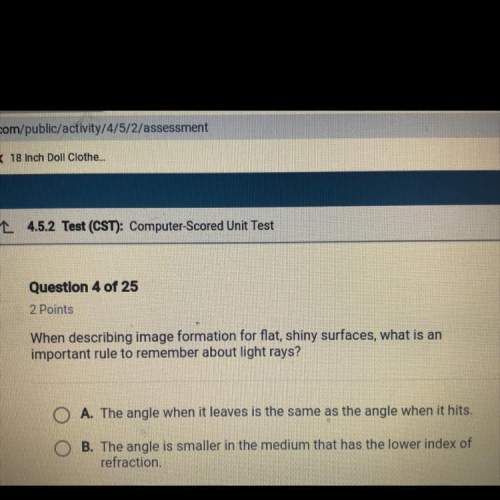
Physics, 11.11.2019 23:31, erikap0889
Acircular disk of radius 10 cm has a constant angular acceleration of 1.0 rad/s2 ; at t = 0 its angular velocity is 2.0 rad/s. (a) determine the disk’s angular velocity at t = 5.0 s . (b) what is the angle it has rotated through during this time? (c) what is the tangential acceleration of a point on the disk at t = 5.0 s ?

Answers: 1
Other questions on the subject: Physics

Physics, 22.06.2019 00:30, Solany6426
Part f - example: finding two forces (part i) two dimensional dynamics often involves solving for two unknown quantities in two separate equations describing the total force. the block in (figure 1) has a mass m=10kg and is being pulled by a force f on a table with coefficient of static friction îľs=0.3. four forces act on it: the applied force f (directed î¸=30â above the horizontal). the force of gravity fg=mg (directly down, where g=9.8m/s2). the normal force n (directly up). the force of static friction fs (directly left, opposing any potential motion). if we want to find the size of the force necessary to just barely overcome static friction (in which case fs=îľsn), we use the condition that the sum of the forces in both directions must be 0. using some basic trigonometry, we can write this condition out for the forces in both the horizontal and vertical directions, respectively, as: fcosî¸â’îľsn=0 fsinî¸+nâ’mg=0 in order to find the magnitude of force f, we have to solve a system of two equations with both f and the normal force n unknown. use the methods we have learned to find an expression for f in terms of m, g, î¸, and îľs (no n).
Answers: 2

Physics, 22.06.2019 10:20, brandon1888
Asmall object with mass 0.200 kg swings back and forth on the lower end of a light rope that is 3.00 m long. the upper end of the rope is attached to the ceiling. as the object swings through its lowest position, where the rope is vertical, the speed of the object is 5.80 m/s. at this point in the motion, what is the tension in the rope? (use g = 9.80 m/s2.)
Answers: 2

Physics, 22.06.2019 10:40, rainbowboi
As you are trying to move a heavy box of mass m, you realize that it is too heavy for you to lift by yourself. there is no one around to , so you attach an ideal pulley to the box and a massless rope to the ceiling, which you wrap around the pulley. you pull up on the rope to lift the box. use g for the magnitude of the acceleration due to gravity and neglect friction forces. once you have pulled hard enough to start the box moving upward, what is the magnitude f of the upward force you must apply to the rope to start raising the box with constant velocity? express the magnitude of the force in terms of m, the mass of the box.
Answers: 1
Do you know the correct answer?
Acircular disk of radius 10 cm has a constant angular acceleration of 1.0 rad/s2 ; at t = 0 its ang...
Questions in other subjects:





Mathematics, 30.08.2019 08:30




Chemistry, 30.08.2019 08:30

English, 30.08.2019 08:30







